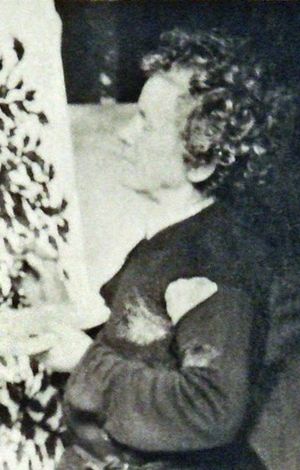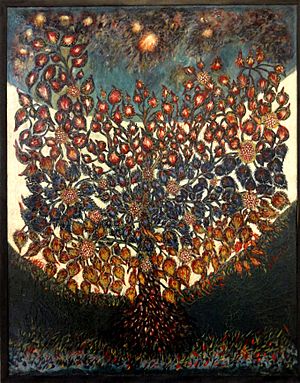Séraphine Louis facts for kids
Séraphine Louis, also known as Séraphine de Senlis (which means Séraphine of Senlis), was a French painter. She was born on September 3, 1864, and passed away on December 11, 1942. Séraphine painted in a style called naïve art. This means her art was simple and natural, without formal training.
She taught herself how to paint. Her strong religious beliefs and the beautiful stained-glass windows in churches inspired her. Her paintings are known for their bright colors and repeated patterns. Some people think these intense images show her own strong feelings and mental health struggles.
Contents
Early Life of Séraphine Louis
Séraphine Louis was born in Arsy, France, on September 3, 1864. Her father was a worker, and her mother came from a farming family. Sadly, Séraphine's mother died on her first birthday. Her father also passed away before she turned seven. After that, her oldest sister took care of her.
Séraphine first worked as a shepherdess, looking after sheep. By 1881, she started working as a domestic worker (a housekeeper) at a convent in Clermont, Oise. From 1901, she worked as a housekeeper for families in the town of Senlis.
Her Painting Career
Séraphine worked hard at her day jobs. But at night, she secretly painted by candlelight. She kept her art hidden for a long time. In 1912, a German art collector named Wilhelm Uhde discovered her amazing work.
While Uhde was in Senlis, he saw a painting of apples at his neighbor's house. He was surprised to learn that Séraphine, who cleaned his own house, was the artist! Uhde started to support her art. However, he had to leave France in August 1914 because of the war between France and Germany.
They lost touch for a while. But in 1927, Uhde returned to France. He visited an art show in Senlis. When he saw Séraphine's paintings, he realized she was still alive and her art was even better. With Uhde's help, Séraphine began painting very large pictures, some as tall as two meters! She became famous as the best naïve painter of her time.
In 1929, Uhde organized an art show called "Painters of the Sacred Heart." This show featured Séraphine's art. She finally earned a lot of money, more than she had ever known. But then, in 1930, the Great Depression hit. This was a time when many people lost their money. Because of this, Uhde could no longer afford to buy her paintings.
Later Life and Passing
In 1932, Séraphine faced serious mental health challenges. She was admitted to a special hospital in Clermont. Sadly, she could not paint there.
Wilhelm Uhde thought she had passed away in 1934. However, some people say Séraphine lived until 1942. She was in a hospital annex in Villers-sous-Erquery. She passed away there, without friends or family nearby. She was buried in a common grave.
After Her Death
Even after Séraphine's death, Wilhelm Uhde continued to show her paintings. Her work was displayed in several important exhibitions:
- In 1932, at "The Modern Primitives" in Paris.
- In 1937–38, in "The Popular Masters of Reality" in Paris, Zurich, and New York (at the Museum of Modern Art).
- In 1942, at "Primitives of the 20th Century" in Paris.
- Finally, in 1945, a solo exhibition of her work was held in Paris.
Séraphine's Artworks
Séraphine's paintings are mostly rich and imaginative pictures of flowers. She often repeated and decorated floral designs. She made her own colors and paints from special ingredients. She never told anyone her secret recipes! These colors have stayed bright and vivid over time. Her paintings look matte, almost waxy.
Sometimes, she carved her signature (usually "S. Louis") into the paint with a knife. This would show a different color underneath. In some cases, it looks like she signed her paintings before she even started painting them!
Séraphine was an artist who felt a strong need to create. She had an "internal necessity" to make art.
Her Lasting Legacy
Today, you can see Séraphine Louis's paintings in several museums. These include the Musée d'art de Senlis, the Musée d'art naïf in Nice, and the Musée d'Art moderne Lille Métropole in Villeneuve-d'Ascq.
In 2009, a French movie about her life was released. It was called Séraphine. The film won seven César Awards, which are like the French Oscars. It won for Best Film and Best Actress for Yolande Moreau, who played Séraphine. The movie shows the story of Séraphine and Wilhelm Uhde, from when they first met until her time in the hospital.
See also
 In Spanish: Séraphine Louis para niños
In Spanish: Séraphine Louis para niños



